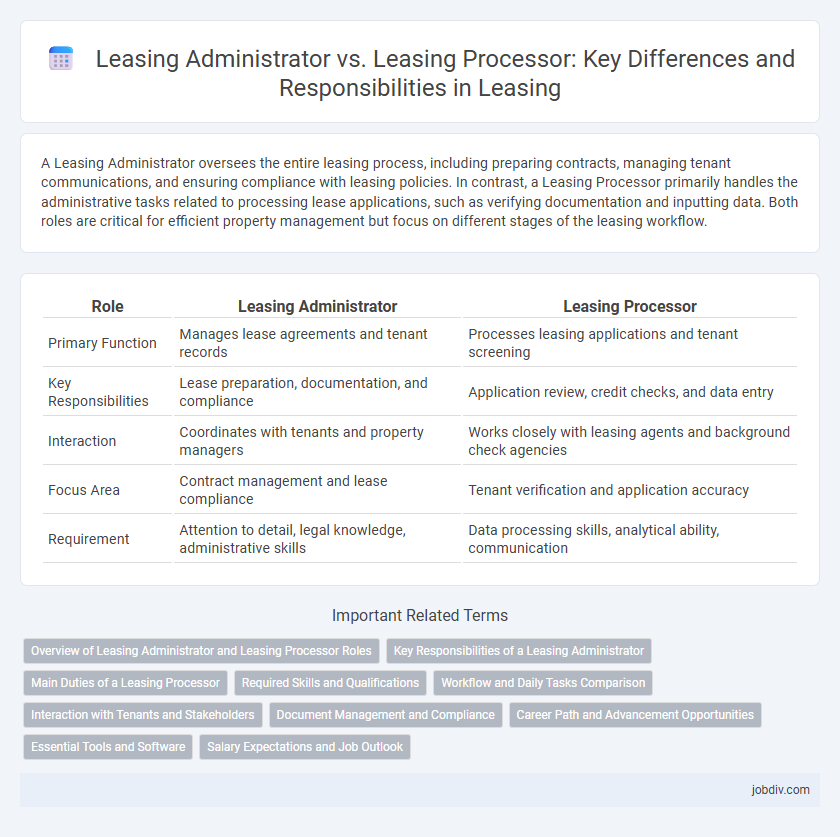A Leasing Administrator oversees the entire leasing process, including preparing contracts, managing tenant communications, and ensuring compliance with leasing policies. In contrast, a Leasing Processor primarily handles the administrative tasks related to processing lease applications, such as verifying documentation and inputting data. Both roles are critical for efficient property management but focus on different stages of the leasing workflow.
Table of Comparison
| Role | Leasing Administrator | Leasing Processor |
|---|---|---|
| Primary Function | Manages lease agreements and tenant records | Processes leasing applications and tenant screening |
| Key Responsibilities | Lease preparation, documentation, and compliance | Application review, credit checks, and data entry |
| Interaction | Coordinates with tenants and property managers | Works closely with leasing agents and background check agencies |
| Focus Area | Contract management and lease compliance | Tenant verification and application accuracy |
| Requirement | Attention to detail, legal knowledge, administrative skills | Data processing skills, analytical ability, communication |
Overview of Leasing Administrator and Leasing Processor Roles
Leasing Administrators oversee lease agreements, ensuring compliance with company policies and legal regulations while managing tenant communications and maintaining lease records. Leasing Processors focus on the initial stages of lease management, including application processing, background checks, and preparing lease documentation for execution. Both roles collaborate to streamline leasing operations, with Administrators handling ongoing lease administration and Processors managing the pre-lease workflow.
Key Responsibilities of a Leasing Administrator
A Leasing Administrator primarily manages lease documentation, ensuring accuracy and compliance with legal standards while maintaining organized records. They coordinate lease renewals, amendments, and tenant communications, streamlining administrative processes. Unlike a Leasing Processor who focuses on application processing and background checks, the Leasing Administrator handles lease agreement finalization and supports property managers in operational tasks.
Main Duties of a Leasing Processor
A Leasing Processor primarily manages the preparation and verification of leasing documents, ensuring accuracy and compliance with legal standards. They coordinate tenant background checks, financial screenings, and respond to inquiries to facilitate smooth lease execution. Their role emphasizes meticulous data entry and maintaining organized lease files to support the leasing team efficiently.
Required Skills and Qualifications
Leasing Administrators require strong organizational skills, proficiency in lease documentation, and expertise in compliance with property management regulations. Leasing Processors must have attention to detail, experience in processing lease applications, and knowledge of tenant screening procedures. Both roles benefit from excellent communication skills and familiarity with property management software.
Workflow and Daily Tasks Comparison
Leasing Administrators manage tenant communications, lease documentation, and compliance monitoring to ensure smooth lease execution and tenant satisfaction. Leasing Processors focus on preparing lease contracts, verifying applicant information, and coordinating approvals to expedite the lease approval process. Workflow differences highlight Leasing Administrators' emphasis on relationship management and record keeping, while Leasing Processors prioritize data accuracy and procedural efficiency.
Interaction with Tenants and Stakeholders
Leasing Administrators directly interact with tenants to address inquiries, coordinate lease agreements, and ensure compliance with leasing terms, fostering strong tenant relationships. Leasing Processors primarily manage documentation and internal approval workflows, collaborating with stakeholders like property managers and finance teams to expedite lease finalization. Effective communication between Leasing Administrators and Processors enhances operational efficiency and tenant satisfaction.
Document Management and Compliance
A Leasing Administrator oversees comprehensive document management by ensuring all lease agreements, amendments, and compliance documents are accurately maintained and updated in centralized systems. A Leasing Processor primarily focuses on the initial verification and processing of lease documentation, ensuring timely submission and adherence to regulatory standards. Both roles require meticulous attention to compliance, but the Administrator manages ongoing documentation integrity while the Processor handles first-phase document accuracy.
Career Path and Advancement Opportunities
Leasing Administrators typically manage lease documentation and tenant communications, providing foundational experience essential for progression into Leasing Manager or Property Manager roles. Leasing Processors focus on application processing and data verification, gaining specialized skills that can lead to advanced positions in leasing operations or compliance departments. Both roles offer distinct career advancement pathways, with Leasing Administrators often advancing into broader property management, while Leasing Processors may move toward operational or administrative leadership.
Essential Tools and Software
Leasing Administrators rely heavily on property management software such as Yardi, RealPage, and Entrata to oversee lease agreements, tenant communications, and compliance documentation efficiently. Leasing Processors use document management tools like DocuSign and Adobe Acrobat to handle lease execution, data entry, and verification workflows with precision. Both roles often utilize CRM systems like Salesforce to streamline tenant tracking and maintain accurate leasing records, enhancing overall operational productivity.
Salary Expectations and Job Outlook
Leasing administrators typically earn between $45,000 and $60,000 annually, reflecting their responsibility for managing lease agreements and ensuring compliance, whereas leasing processors often have a salary range of $35,000 to $50,000 due to their focus on documentation and application processing. Job outlook for leasing administrators shows steady growth driven by increasing real estate activity and demand for lease management expertise, while leasing processors experience moderate demand primarily in property management firms. Both roles offer opportunities for advancement, but leasing administrators generally have higher earning potential linked to greater responsibilities.
Leasing Administrator vs Leasing Processor Infographic

 jobdiv.com
jobdiv.com